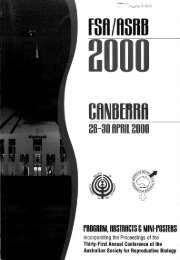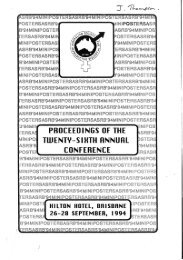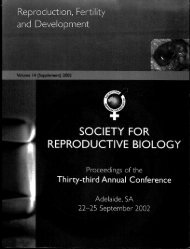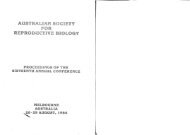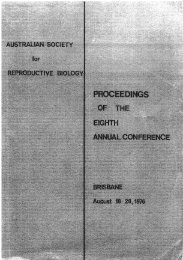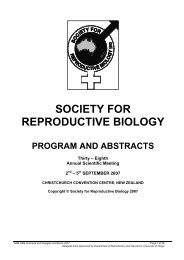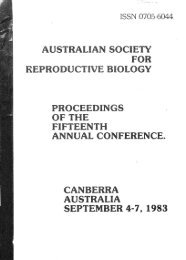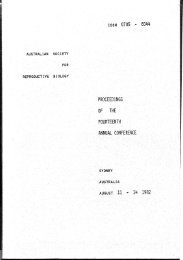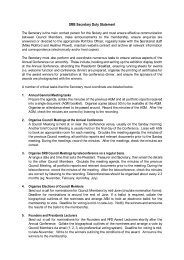N OCIETY' - the Society for Reproductive Biology
N OCIETY' - the Society for Reproductive Biology
N OCIETY' - the Society for Reproductive Biology
Create successful ePaper yourself
Turn your PDF publications into a flip-book with our unique Google optimized e-Paper software.
Identification of proteins with seasonal patterns of secretion in ram seminal plasma.J. F. Smith, R. S-F. Lee, R. M. McDonald, G. R. Murray, J. Parr.AgResearch, Ruakura Research Centre, Private Bag 3123, Hamilton, New Zealand.INTRODUCTION: Ram semen collected and frozen in<strong>the</strong> non-breeding season is of lower fertility than semenfrom <strong>the</strong> same animals in <strong>the</strong> autumn. These changes in <strong>the</strong>fertility of frozen semen cannot be readily explained bychanges in sperm numbers alone, although associatedalterations in maintenance of sperm motility after freezinghave been reported (1). Differences in field fertility afterinsemination with frozen bull semen have been linked toconcentrations of specific seminal plasma proteins (2).This observation raises <strong>the</strong> possibility that certain seminalplasma proteins could influence <strong>the</strong> ability of sperm toretain <strong>the</strong>ir fertility after cryopreservation; thus, seasonalchanges in fertility of ram semen could be related toalterations in <strong>the</strong> composition of seminal plasma. Thepresent experiment was conducted to examine <strong>the</strong> seasonalvariations in protein content and composition of ramseminal plasma.METHODS: Ten rams of proven fertility were used in thisstudy. On one day each month two or three ejaculates werecollected by artificial vagina from each ram. Semensamples were kept on ice after collection and evaluated <strong>for</strong>volume and density, <strong>the</strong>n processed. Proteolytic inhibitors(benzamine and PMSF) were added to. a finalconcentration of 1 roM each and <strong>the</strong> seminal plasmaseparated by centrifugation (2x 10 min) at 1l,600g. Equalvolumes of seminal plasma from each ejaculate collectedon <strong>the</strong> same day <strong>for</strong> an individual ram were pooled,aliquoted and stored at -20°C until assay. Protein contentof <strong>the</strong> seminal plasma was determined using a modifiedLowry method (3). Seminal plasma proteins were analysedby electrophoresis in 12.5 % denaturing acrylamide gelsafter 5-fold dilution in 10 rnM Tris-Cl, pH 8.0, containing1 mM EDTA. After electrophoresis and staining withCoomassie-blue, <strong>the</strong> protein banding patterns were visuallyappraised. Samples from individual rams <strong>for</strong> each of <strong>the</strong> 12months were compared within <strong>the</strong> same gel and <strong>the</strong> proteinloading was normalised across all <strong>the</strong> lanes to correct <strong>for</strong>variation in protein concentration between <strong>the</strong> samples.Protein identification. Five proteins that showed seasonalvariation were selected <strong>for</strong> identification by peptidesequencing. Briefly, seminal plasma proteins (40 Ilg perlane) were electrophoresed in denaturing 12.5 %polyacrylamide gels (20 x 20 x 0.075 cm). After stainingwith Coomassie-blue and destaining, <strong>the</strong> bands of interestwere excised, and depending on <strong>the</strong> abundance of <strong>the</strong>protein, ei<strong>the</strong>r bands from 5 lanes or 10 lanes werecombined and <strong>the</strong> gel pieces washed extensively withwater, <strong>the</strong>n 50 roM Tris-HCI, pH 8.5, containing 1 roMEDTA. The gel pieces were pulverized and suspended in0.4 mI of <strong>the</strong> same buffer and Endoproteinase Lys C(sequencing grade, Promega), added to a finalconcentration of 0.1 mg/mI. The mixture was incubated at37°C overnight with shaking and <strong>the</strong> supernatant was <strong>the</strong>nseparated from <strong>the</strong> gel slurry and volume reduced to < 100III by lyophillization. After acidication with trifluoroaceticacid to a final concentration of 1 % (v/v), <strong>the</strong> peptideswere resolved by reverse-phase HPLC. Individual peptidepeaks eluting from <strong>the</strong> column were collected and selected40peak samples were subjected to ~no acid sequencingusing <strong>the</strong> Applied Biosystems PrOCIse Sequencer (ABI).RESULTS: A seasonal change in <strong>the</strong> total proteinconcentration was detected in seminal plasma, with higherlevels (36.9 vs 23.0 mg/mI; P



